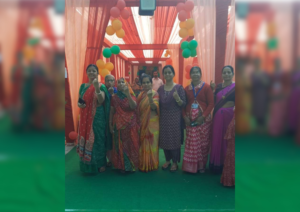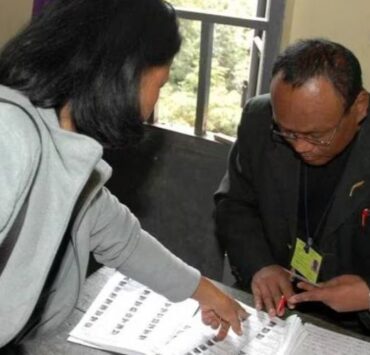
By Rakhee Roytalukdar

The Legislative Assembly elections in the last quarter of 2023 saw political parties competing for the attention of female voters. With women emerging as a crucial voting bloc, welfarism emerged as the common running theme across parties and states.
In Rajasthan, the percentage of women exercising their franchise has been rising consistently. In the 2003 Assembly elections, the voting percentage of female voters was 64.21%; in 2018, the percentage stood at 74.67%. In the recent 2023 elections, more women voted than men again, registering 74.72%, while 74.53% of the state’s men voted in the polls. Rajasthan went to the polls on November 25; the results were declared on December 3.
Both the Bharatiya Janata Party (BJP) and the Indian National Congress (INC, Congress) had on offer several welfare schemes, ranging from subsidised LPG (gas) cylinders, smart phones, transport, healthcare, education and housing to direct cash transfers. Most of these schemes were aimed at female beneficiaries from families classified as Above Poverty Line (APL) and Below Poverty Line (BPL) – that is, belonging mainly to economically disadvantaged classes. However, there was another category of women who did not need this kind of largesse but nevertheless constituted an equally valuable vote-bank: middle and upper class women.
While the Congress remained focussed on strategising around welfare schemes based on guarantees, the BJP’s well-oiled electoral machinery and organisational power enabled it to zero in on this unexplored category of women – mainly urban homemakers and/or professionals – viewed as politically significant for the party.
The BJP’s election strategists realised early in the lead-up to the polls that welfarism alone cannot bring in votes and has its limits. And that for positive electoral outcomes voters, especially female voters belonging to middle and upper classes, have to be offered something that would appeal to them: possibly something related to religion and religious identity. They surmised that these women would perhaps respond positively to the concept that India belongs fundamentally to the Hindu majority despite the fact that it is a secular nation according to the Constitution.
A Lokniti-CSDS survey published in The Hindu on 6 December 2023 lends credence to this line of thinking because it questioned the reach and effectiveness of welfare schemes initiated by the Congress, till recently the ruling party in the state. The survey found that the Indira Gandhi Cylinder Yojana (subsidised LPG cylinder) proved beneficial for nearly two in three voters (63%). The largest proportion of beneficiaries consisted of the Scheduled Tribes (71%), Muslims (65%) and those belonging to the lower economic classes (69%). The Congress was able to secure a decent advantage over the BJP only among the beneficiaries of the gas cylinder scheme and the Urban Employment Scheme.
Dr Anastasia Piliavsky, a Reader in Social Anthropology and Politics in the India Institute at King’s College, London, who works on India’s democracy and the role of vernacular values, recently wrote an editorial page article in The Times of India about the BJP’s strategy to win over the hitherto untapped segment of middle and upper class female voters. According to her, “In 2022, BJP came up with a brilliant plan – to plug and support local women’s networks – during the UP state elections. Some of these were new, like the ‘Kamal Saheli Clubs’, and some were old, like the mandals and ‘kitty parties.’ It worked: in UP a Lokniti Survey showed that 13% more women preferred BJP as opposed to only 5% more men.” “This year, the BJP applied this strategy to Rajasthan, where it had another big victory, with women again voting more than men,” she pointed out.
BJP cadres mapped the social demography precisely and focussed on mahila mandals, an old urban institution in cities and towns across the desert state. As Piliavsky has observed, these mandals have women from “respectable Hindu families” as members, and constitute “powerful cross-caste networks of social support”. Turning neighbours into friends, mandals are real bastions of Hindu middle-class solidarity, according to her.
Piliavsky’s article referred to the women of one particular mahila mandal in Jaipur with whom she interacted. They came into contact with the local BJP Mahila Morcha during the Covid lockdown and subsequently began attending each other’s events, including tea parties. The continued interaction with women owing allegiance to the BJP strengthened the idea of dharam (faith/creed) and desh (nation) among them. According to Piliavsky, the housewives who are members of the mandal “regularly attend temples, perform daily rituals and watch Hindu epics on TV.” “This is our country, the Hindu Rashtra, the women said to me, again and again,” she reported.
The invocation of national pride, reclamation of the civilisational past, India’s growing global stature, and so on, combined with Narendra Modi’s rhetoric about the Opposition’s so-called appeasement politics (tushtikaran ki rajneeti), its “attack” on Sanatan Dharma and its supposed attempt to finish off the culture of Rajasthan, appear to have resonated with this category of voters.
Moreover, the women’s wing of the RSS, the Rashtra Sevika Sangh, has been working behind the scenes for years in Rajasthan along with the mahila mandals. Both RSS shakhas and mahila mandals mostly comprise women from the upper and middle classes.
The mandals hold regular meetings to discuss the challenges modern women face in running their households and families alongside their jobs. Apart from socialising and emphasising the importance of physical training, professionals in these groups – such as doctors, teachers, engineers and chartered accountants – often bring up common issues that affect them, like motherhood and work-life balance. They also talk about national pride and their role in nation-building, which are the BJP’s major electoral planks.
In the build-up to the recent state elections, the BJP also mobilised its senior women leaders from mahila morchas in other states to woo women voters in Rajasthan, publicising the Modi government’s schemes and programmes. According to the plan, two teams worked in each mandal: one in the morning and the other in the evening. They reached out to female voters with street corner meetings and door-to-door campaigns. With religion and the Hindu narrative as their leitmotif, they also made Modi’s schemes and Modi ki Guarantee their talking points.
The combined strategy appears to have worked. According to the Lokniti survey, voters benefitting from the Union government’s welfare schemes tended to vote for the BJP even in the state election. In the case of Ujjawala Yojana (providing LPG connections to women from BPL families), 45% of the beneficiaries voted for the BJP while 36% voted for the Congress; among the beneficiaries of the Ayushman Bharat Pradhan Mantri Jan Arogya Yojana (national public health insurance scheme), the BJP maintained a five percent lead.
The BJP won the 2023 state elections in Rajasthan with 115 seats in the Assembly, as against the 69 won by the Congress. A total of nine female candidates fielded by the BJP also won and are now members of the legislature (MLAs).
Rakhee Roytalukdar has been a journalist for more than 25 years. She has been writing on politics, gender issues, tourism, wildlife, human interests and other topics. Having started with The Telegraph, she has worked with The Times of India, IANS, The Pioneer, UNI and others. She covered Rajasthan as a correspondent for The Telegraph for more than 10 years. She is now writing for Deccan Herald.




